Arizona is home to a fascinating variety of rattlesnakes, making it one of the best places in the United States to observe these iconic reptiles. With its diverse landscapes ranging from deserts to mountainous forests, the state supports many different species. In this article, we’ll explore the types of rattlesnakes in Arizona, highlighting their unique features and habitats.
Understanding the types of rattlesnakes in Arizona is important for both wildlife enthusiasts and residents. Each species has distinct markings, behaviors, and venom potency, which can help in identification and safety awareness. For those interested in nature or spending time outdoors, knowing these rattlesnakes can enhance the experience and respect for Arizona’s wildlife.
From the widely known Western Diamondback to the rare and elusive Grand Canyon Rattlesnake, this guide covers 16 different types of rattlesnakes in Arizona. Along with pictures and identification tips, you’ll learn where to find them and what makes each species unique in this diverse southwestern state.
Different Types of Rattlesnakes in Arizona
Western Diamondback Rattlesnake (Crotalus atrox)

The Western Diamondback Rattlesnake is the most widespread and commonly encountered rattlesnake in Arizona and the entire southwestern United States. It can grow up to 4 to 5 feet in length, with a distinctive pattern of dark diamond shapes bordered by light scales running along its back. Its tail ends with a series of black and white bands followed by a rattle, which it uses as a warning signal when threatened.
This species is highly adaptable and thrives in a variety of habitats including deserts, grasslands, rocky hillsides, and even suburban areas. It is frequently found near washes, under rocks, or basking along roadsides. Its activity increases during spring and fall, but it may also emerge on warm winter days or hunt at night during the summer heat.
Western Diamondbacks have a hemotoxic venom that causes tissue damage, swelling, and bleeding, but fatalities are rare with prompt medical treatment. They primarily feed on small mammals like rodents and rabbits, but will also eat birds and reptiles. Their wide distribution and tolerance of human presence make them one of the most frequently encountered venomous snakes in Arizona.
Mojave Rattlesnake (Crotalus scutulatus)

The Mojave Rattlesnake is a medium-sized rattlesnake known for its potent neurotoxic venom. It typically ranges from 2.5 to 4 feet long and is often mistaken for the Western Diamondback due to similar coloration, though it can be distinguished by the greenish tinge of its scales and narrower black-and-white tail bands. The head is broad and triangular, typical of pit vipers.
This species is common in the arid lowlands of southern and central Arizona, including desert scrub, grasslands, and open plains. It prefers flat, open terrain with sparse vegetation and often uses rodent burrows for shelter. While primarily nocturnal during the hot summer months, it may be seen basking in the morning or late afternoon during spring and fall.
The Mojave Rattlesnake is infamous for having one of the most toxic venoms of any rattlesnake species in North America, combining both neurotoxic and hemotoxic effects in some populations. Despite its danger, it rarely bites unless provoked. Its diet consists mainly of rodents, small birds, and lizards, helping it to control pest populations in its ecosystem.
Sidewinder Rattlesnake (Crotalus cerastes)
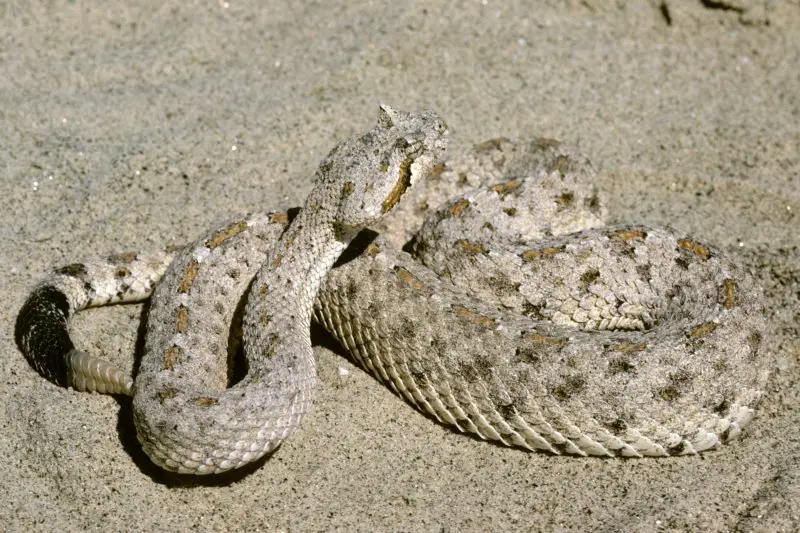
The Sidewinder Rattlesnake is named for its distinctive method of locomotion, where it moves sideways across sandy terrain to minimize contact with hot desert surfaces. It is a relatively small species, usually 1.5 to 2.5 feet long, with a pale tan or gray body that blends well with desert sand. Its most notable feature is the raised supraocular “horns” above its eyes, which help shade them from the sun.
This species is commonly found in the sandy deserts of southwestern Arizona, especially around the Yuma region and the Mojave Desert. It prefers loose, dry soils where it can burrow or partially bury itself, lying in wait for prey. It is primarily nocturnal during summer, emerging at dusk to hunt and avoid extreme daytime heat.
Sidewinders have a moderately potent venom that is hemotoxic, used to subdue small prey like lizards, rodents, and occasionally birds. While not considered highly dangerous to humans, bites still require medical attention. Despite their small size and cryptic nature, they are one of the more easily spotted rattlesnakes in desert regions due to their unique movement patterns and surface tracks.
Arizona Black Rattlesnake (Crotalus cerberus)

The Arizona Black Rattlesnake is a striking species often found in forested highlands and mountainous areas of central and northern Arizona. Adults typically grow between 2.5 to 3.5 feet long and have a dark brown to nearly black coloration, though juveniles display lighter banded patterns. As they mature, these snakes often darken significantly, helping them blend into shaded forest floors.
This species primarily inhabits elevations above 4,000 feet, especially within the Mogollon Rim and the mountainous regions of the Coconino and Tonto National Forests. Unlike many desert-dwelling rattlesnakes, the Arizona Black prefers cooler, more humid environments. It is often encountered near streams, rocky slopes, and pine or oak woodlands.
Known for its relatively calm demeanor, this snake uses its hemotoxic venom to immobilize prey such as rodents, lizards, and small birds. It is also one of the few rattlesnake species that exhibit maternal care—females may stay with their newborns for several days after birth. Their reclusive habits and preference for remote, forested areas make them less frequently seen than their desert counterparts.
Tiger Rattlesnake (Crotalus tigris)
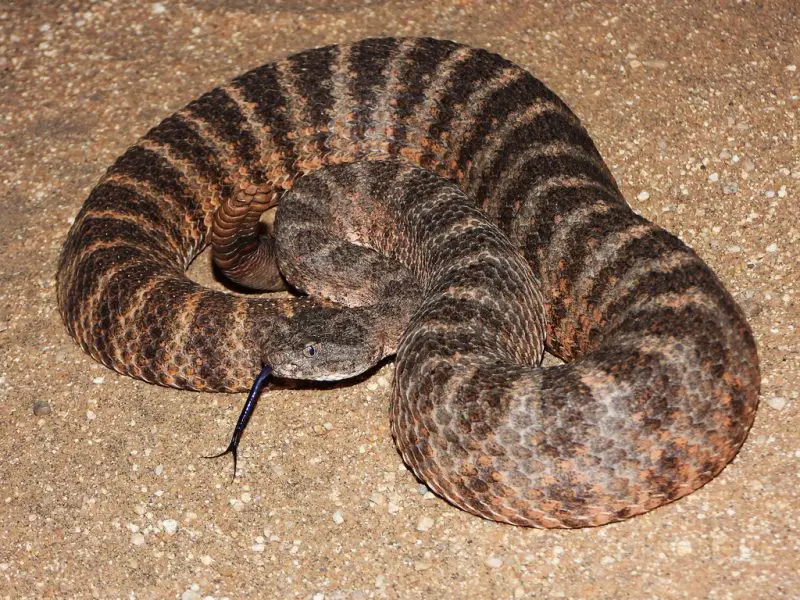
The Tiger Rattlesnake is a relatively small but highly venomous rattlesnake known for its narrow head and distinctive crossbanded pattern, which resembles tiger stripes. Adults typically range from 1.5 to 2.5 feet in length. Their coloration varies from pale gray to lavender or pinkish hues, blending well with the rocky terrain of their habitat.
This species is fairly common in southern Arizona, especially from Tucson to the Sierra Vista area. It thrives in rocky hillsides, desert canyons, and shrub-covered slopes, often near washes or boulder-strewn ravines. Though mainly crepuscular and nocturnal during hot weather, it may be active during the day in cooler seasons.
Despite its small size, the Tiger Rattlesnake possesses one of the most toxic venoms among North American rattlesnakes, with strong neurotoxic and myotoxic effects. It uses this potent venom to capture lizards and small mammals. Due to its secretive nature and preference for rugged terrain, encounters with humans are uncommon.
Northern Black-Tailed Rattlesnake (Crotalus molossus molossus)

The Northern Black-Tailed Rattlesnake is a large and striking species, typically 3 to 4 feet in length, with a yellowish, olive, or tan body and a solid black tail just before the rattle. It has a relatively slender build and a calm demeanor compared to other rattlesnakes, making it less prone to defensive behavior unless provoked.
This snake is found relatively frequently in mountainous and hilly regions of southern and central Arizona. It prefers rocky outcrops, forested slopes, and desert foothills, where it often shelters in crevices or under logs. Unlike many other species, the Northern Black-Tailed Rattlesnake is active during both day and night, depending on temperature and season.
Its venom is primarily hemotoxic and used to immobilize prey such as rodents, birds, and reptiles. The species plays an important role in controlling rodent populations in its habitat. Because of its striking appearance and relatively non-aggressive nature, it is often admired by herpetologists and nature enthusiasts.
Speckled Rattlesnake (Crotalus mitchellii)
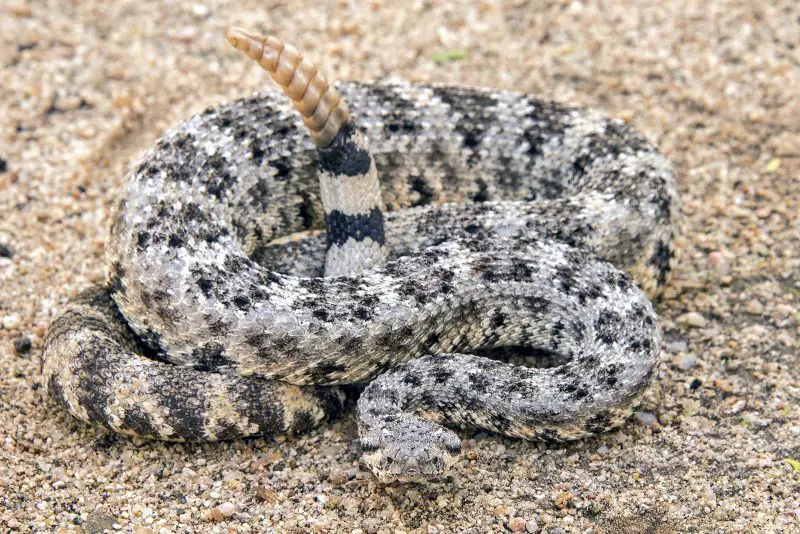
The Speckled Rattlesnake is well-camouflaged in its rocky surroundings, with a body color that often matches the hue of the local stone, ranging from gray to pink, tan, or even bluish tones. Adults typically measure 2 to 3 feet in length. Its pattern of irregular speckles and blotches provides excellent concealment against desert and mountain rocks.
This species is fairly common in rugged, rocky terrain across southern and southwestern Arizona, including desert mountains, cliffs, and canyons. It favors sunlit boulders and talus slopes where it can bask during the day or hunt in the early morning and evening. It tends to remain motionless when threatened, relying on camouflage rather than aggression.
The venom of the Speckled Rattlesnake is hemotoxic, and while not considered highly dangerous to humans, it is effective in subduing small mammals, birds, and lizards. Because it blends so well into its environment, hikers and climbers may pass nearby without ever realizing it is there.
Arizona Ridge-Nosed Rattlesnake (Crotalus willardi willardi)
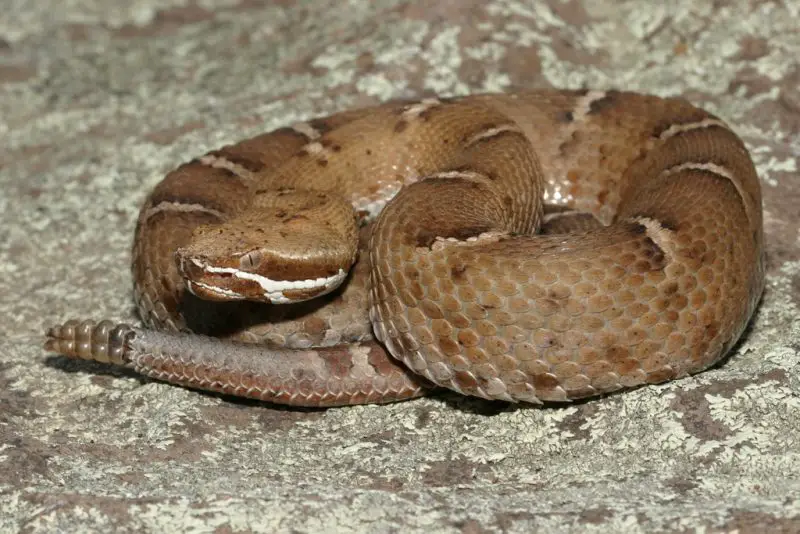
The Arizona Ridge-Nosed Rattlesnake is a small, secretive species that rarely exceeds 2 feet in length. It is named for the distinctive raised ridges along each side of its nose. Its coloration includes a reddish-brown to chocolate background marked with narrow white or pale crossbands, helping it blend into leaf litter on the forest floor.
This rattlesnake is the official state reptile of Arizona but is not commonly encountered. It is restricted to the “Sky Islands” of southeastern Arizona—isolated mountain ranges like the Huachuca, Chiricahua, and Santa Rita Mountains—at elevations between 5,000 and 8,000 feet. It inhabits pine-oak woodlands and shaded canyons with plenty of moisture.
Its venom is relatively mild and mainly hemotoxic, used to hunt small amphibians, lizards, and rodents. Because of its reclusive behavior, limited range, and elevation preference, it is rarely seen by the general public and is considered of conservation concern in parts of its range.
Twin-Spotted Rattlesnake (Crotalus pricei)

The Twin-Spotted Rattlesnake is a small, slender species with a muted gray or bluish background color and two parallel rows of dark brown or black spots running down its back. Adults typically measure between 18 to 24 inches in length, making it one of the smaller rattlesnake species in Arizona. It has keeled scales and a narrow, pointed head that helps it maneuver among rocks and forest debris.
This rattlesnake is considered uncommon but can be found in higher elevations, especially within the pine and oak forests and granite outcrops of the Huachuca Mountains in southeastern Arizona. It is most often encountered by researchers or hikers who venture into remote mountainous terrain above 6,000 feet, particularly in cooler, wetter microhabitats.
The Twin-Spotted Rattlesnake’s venom is primarily hemotoxic and used to immobilize small prey such as lizards, amphibians, and small rodents. Due to its remote habitat and shy behavior, human encounters are extremely rare. It tends to rely on camouflage and avoidance rather than confrontation when threatened.
Banded Rock Rattlesnake (Crotalus lepidus klauberi)
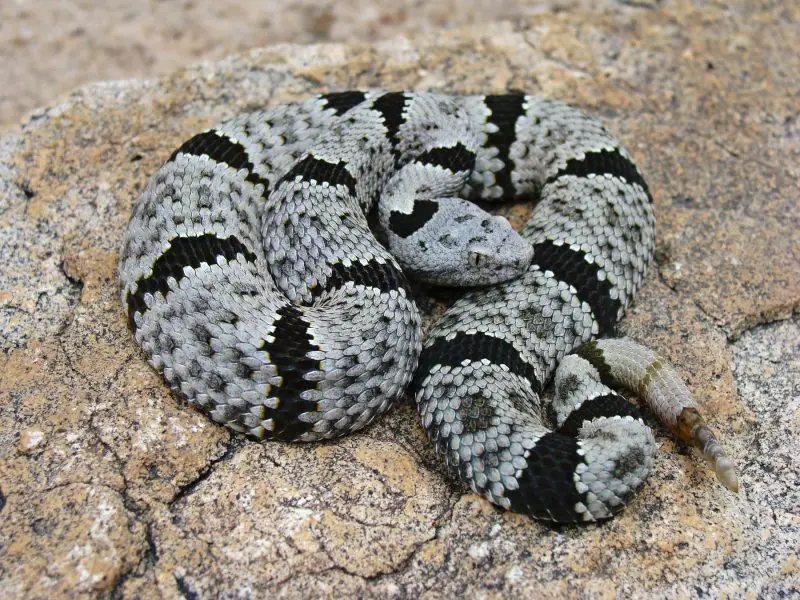
The Banded Rock Rattlesnake is known for its beautiful and variable appearance, with a background color that often matches local rocks—gray, lavender, or greenish hues—interrupted by bold, dark bands across its body. Adults are relatively small, usually under 2.5 feet in length. This species has a broad, triangular head and a thick body compared to its short length.
It is relatively rare and occupies a limited range in southeastern Arizona, especially in isolated, rocky mountain areas such as the Chiricahua, Huachuca, and Santa Rita Mountains. It favors shady crevices, rocky canyons, and forested slopes. Because it is so cryptic and remains motionless when approached, it is seldom seen even in areas where it is present.
The Banded Rock Rattlesnake’s venom is moderate in potency and helps it subdue small reptiles and mammals. Despite its striking appearance, this species is shy and non-aggressive, rarely rattling unless directly threatened. It is a favorite subject of herpetologists and wildlife photographers because of its beautiful coloration and elusive nature.
Grand Canyon Rattlesnake (Crotalus oreganus abyssus)
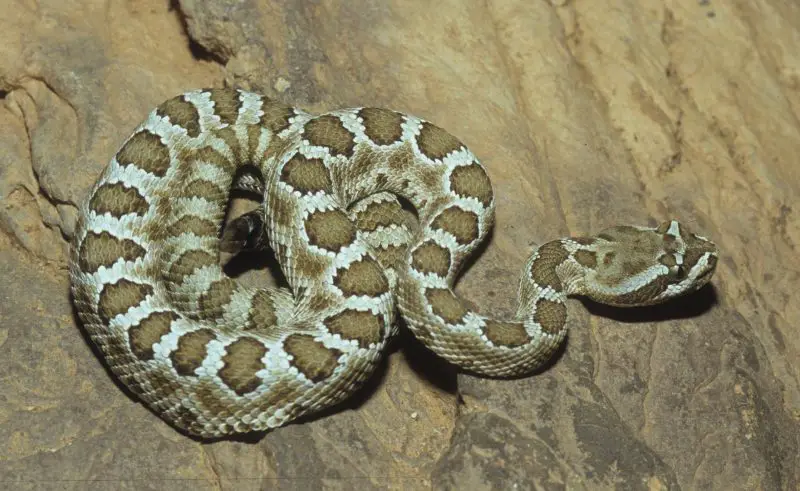
The Grand Canyon Rattlesnake is a unique and localized subspecies of the Western Rattlesnake, known for its reddish or pinkish tones that match the surrounding rock formations of the Grand Canyon. It has blotched patterns along its back and a strong, muscular build, usually growing up to 3.5 feet long. Its coloration offers excellent camouflage in canyon environments.
This rattlesnake is found only within the Grand Canyon and nearby plateau regions, making it geographically restricted and not widespread across Arizona. It inhabits rocky ledges, canyon slopes, and desert scrub near riverbanks and hiking trails. Visitors to the Grand Canyon occasionally encounter this species, especially during warmer months when it’s more active.
The venom of the Grand Canyon Rattlesnake is hemotoxic, used to hunt rodents, birds, and lizards. Though potentially dangerous, bites are rare and typically occur only when the snake is accidentally provoked. It plays an important ecological role in the isolated canyon ecosystem and is considered a symbol of the region’s biodiversity.
Prairie and Hopi Rattlesnake (Crotalus viridis)
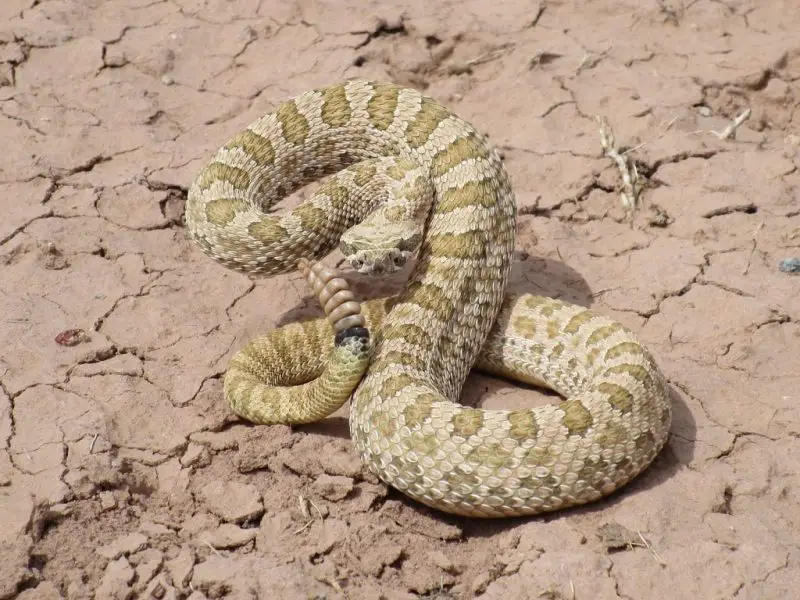
The Prairie and Hopi Rattlesnakes represent regional variations of Crotalus viridis, which is generally light brown or olive with darker diamond or blotch-shaped patterns along its back. These snakes have relatively slender bodies and can grow up to about 3.5 feet in length. Their subtle coloring helps them blend into the grasslands and rocky plains.
In Arizona, these rattlesnakes occur mainly in the northeastern part of the state, including the Painted Desert and areas near the Hopi and Navajo Nations. Their habitat includes grasslands, shrublands, and semi-arid plateaus. Due to the remoteness of their range and low human population in the area, encounters are infrequent.
The venom of these snakes is primarily hemotoxic and aids in subduing small mammals and birds. Though not considered as potent as some other species, bites can still be medically significant. These rattlesnakes tend to be shy, often fleeing or remaining motionless rather than rattling when approached.
Desert Massasauga (Sistrurus tergeminus edwardsii)
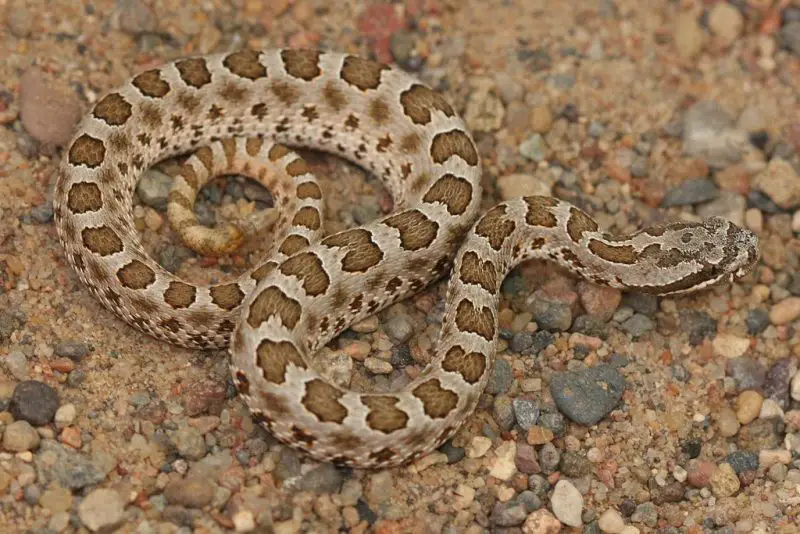
The Desert Massasauga is a small, secretive rattlesnake species, usually measuring less than 2 feet in length. It has a light gray or tan body marked with dark brown or black blotches along its back. Compared to larger rattlesnakes, it has a more delicate build and a relatively small rattle. Its head is broad but proportionally smaller than some other rattlesnakes.
This species is very rare in Arizona and is found primarily in the desert grasslands and shrublands of the southeastern part of the state. Due to habitat loss and other environmental pressures, its population here is extremely limited, making sightings quite uncommon. It prefers areas with dense vegetation where it can remain concealed during the day.
The Desert Massasauga’s venom is moderate and primarily hemotoxic, used to immobilize small rodents, amphibians, and insects. Because of its small size and shy behavior, it rarely poses a threat to humans. Conservation efforts aim to protect its remaining habitats to prevent further decline.
New Mexico Ridge-Nosed Rattlesnake (Crotalus willardi obscurus)
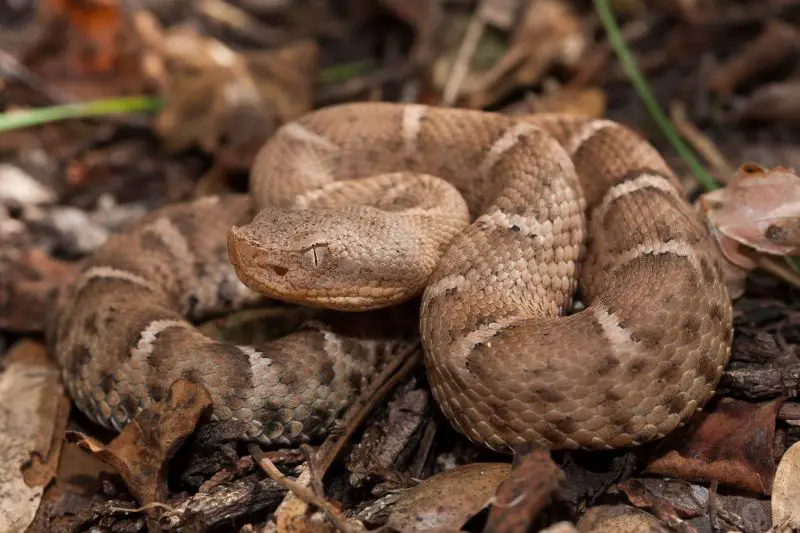
The New Mexico Ridge-Nosed Rattlesnake is a rare subspecies distinguished by the raised scales along its nose, similar to its close relative the Arizona Ridge-Nosed Rattlesnake. It typically grows to about 18 to 24 inches and has reddish-brown coloration with pale crossbands. Its head is narrow and angular, adapted for navigating rocky crevices.
In Arizona, this rattlesnake has only been recorded in high-elevation mountain ranges near the New Mexico border. It inhabits pine-oak woodlands and shaded canyons, preferring cooler, moist microhabitats at elevations above 6,000 feet. Due to its restricted range and secretive nature, encounters are extremely rare.
Its venom is mild compared to other rattlesnakes but still effective at subduing small prey such as lizards, frogs, and small mammals. Because of its limited distribution and rarity, it is considered vulnerable and protected under state conservation laws.
Great Basin Rattlesnake (Crotalus oreganus lutosus)
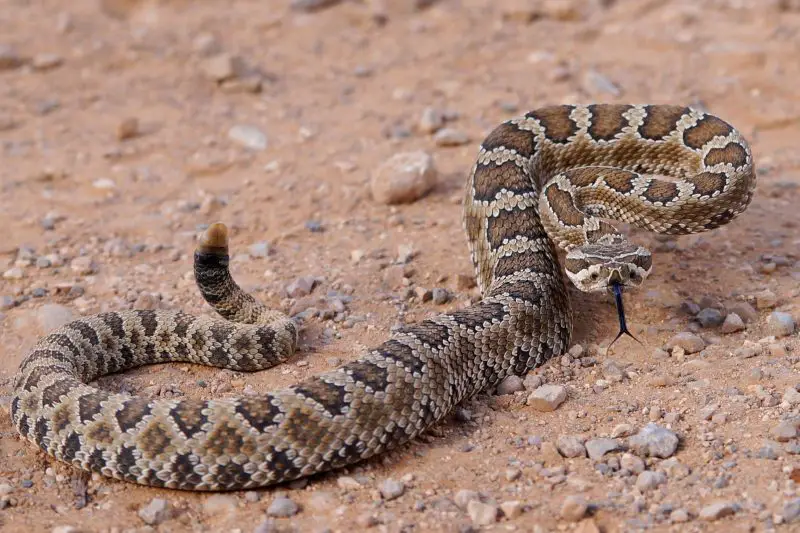
The Great Basin Rattlesnake is a large rattlesnake species often reaching lengths of 3 to 4 feet. It has a robust body with a coloration that ranges from gray to brown, featuring darker blotches or saddles along its back. Its pattern provides excellent camouflage in rocky, arid environments. The head is broad with a distinctive rattle used for warning predators or threats.
Within Arizona, this rattlesnake appears only in the extreme northeastern corner of the state, where it inhabits high desert plateaus and rocky foothills. Its presence is very rare in Arizona compared to other states in its range, which includes Utah, Nevada, and parts of California.
The venom of the Great Basin Rattlesnake is mainly hemotoxic, used to immobilize small mammals and reptiles. Though bites are uncommon due to its rarity in Arizona, its venom is medically significant. It tends to avoid human contact, usually rattling and retreating when disturbed.
Mottled Rock Rattlesnake (Crotalus lepidus lepidus)

The Mottled Rock Rattlesnake is a small to medium-sized species, measuring around 18 to 30 inches. It is recognized for its mottled, speckled pattern that blends perfectly with rocky terrains. Its coloration varies from gray to brown, often with faint bands and spots. It has keeled scales and a slender build adapted for rocky habitats.
This species is commonly found in Texas and New Mexico but has been very rarely documented in the far eastern edge of Arizona. It inhabits mountainous regions, rocky canyons, and cliffs, favoring shaded crevices and talus slopes where it can avoid predators and extreme heat.
The Mottled Rock Rattlesnake’s venom is moderate, effective in subduing small mammals and reptiles. It is generally non-aggressive, relying on camouflage and stillness to avoid threats. Due to its rarity in Arizona, it is not well studied in the state but remains an interesting part of the regional rattlesnake diversity.






